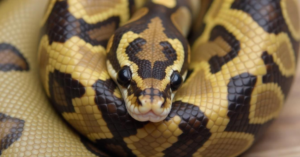Introduction
Have you ever wondered about the fascinating variety of ball python morphs? These snakes are not just stunning to look at—they’re a masterpiece of genetics! Ball python morphs are unique variations of ball pythons that showcase incredible color patterns and intricate python morph patterns. With hundreds of morphs available, morph identification can feel overwhelming. This visual guide will break it down step by step, helping you understand the role of ball python genetics in creating these captivating reptiles.
Understanding Ball Python Morphs
What is a Morph?
A morph refers to a genetic mutation that affects a ball python’s color patterns, body patterns, or both. Unlike their wild-type counterparts, ball python morphs are selectively bred for their remarkable appearances. The sheer variety of python morph patterns available today has made them a popular choice among reptile enthusiasts.
The Role of Genetics in Morph Development
Ball python genetics plays a key role in how morphs develop. Morphs are created by specific genetic traits that can be dominant, co-dominant, or recessive, influencing their appearance. Understanding these genetic mechanisms can help simplify the process of morph identification.
Visual Traits to Observe
To successfully identify a ball python morph, it’s crucial to focus on specific visual traits such as color patterns, head markings, and body patterns.
Head Patterns
The head of a ball python often provides clues about its morph. For example, Spider morphs typically have reduced head markings, while Clown morphs feature simpler, cleaner head patterns.
Body Patterns
Some morphs, like Piebald Ball Pythons, have irregular white patches, while others, like Axanthic morphs, maintain classic python patterns but lack warm pigments.
Color Variations
- Albino Ball Pythons: These morphs are instantly recognizable with their vibrant yellow and white coloration, complemented by red eyes.
- Pastel Morphs: Known for their brighter yellow tones and faded blacks, Pastels are among the most popular morphs.
- Clown Morphs: These feature minimalist patterns paired with vibrant, clean colors.
Popular Ball Python Morphs
Classic Morph
The “normal” or wild-type ball python serves as the standard. It has earthy tones and irregular blotches, forming the baseline for python morph guides.
Albino Ball Python
Albino Ball Pythons stand out due to their bright yellow and white hues. They lack melanin, giving them their distinct appearance.
Pastel Morph
Pastel morphs are known for their vibrant colors and softer black patterns. These morphs are often combined with others to enhance the brightness of new morphs.
Piebald Ball Python
This fan-favorite features sections of pure white alongside standard patterning, creating a dramatic and unique appearance.
Spider Morph
Spider morphs display web-like patterns across their bodies, paired with golden-brown hues. These unique patterns make them easy to spot during morph identification.
Rare and Unique Morphs
Axanthic Morph
Axanthic morphs lack warm pigments, resulting in grayscale hues of silver and black. This muted yet striking appearance makes them a highly sought-after morph.
Banana Morph
True to its name, the Banana morph is marked by yellow spots on a lavender background. Its bright coloration makes it a favorite among enthusiasts exploring rare ball python morphs.
Clown Morph
The Clown morph stands out with its bold, clean patterns and dark, striped tail. These visually striking traits make it a popular morph in the community.
Tips for Identifying a Morph
- Compare Visual Traits: Match the snake’s color patterns and body markings with examples from trusted python morph guides.
- Understand Breeding Records: Genetic history is crucial for determining the morph. Knowing the parents’ traits can narrow down possibilities.
- Leverage Resources: Use online morph identification tools and participate in expert forums to gain deeper insights.
Challenges in Identifying Morphs
Similar Morph Overlaps
Some morphs, like Butter and Lesser, exhibit nearly identical traits. This overlap can make morph identification a bit tricky, even for experienced breeders.
Lighting and Environment
Lighting conditions can significantly influence how a morph’s true colors appear. Always evaluate your snake under natural or consistent lighting to ensure accuracy.
Tools and Resources for Morph Identification
- Online Morph Guides: Websites like Morph Market and other platforms offer comprehensive catalogs of ball python morphs for easy identification.
- Expert Communities: Joining forums or engaging with social media groups dedicated to python morph patterns provides valuable insights and support.
Caring for Different Morphs
Do Morphs Require Special Care?
Most ball python morphs don’t need unique care; their requirements are the same as wild-type pythons.
General Care Guidelines
- Maintain the correct temperature and humidity for their enclosure.
- Provide secure hiding spaces to ensure they feel safe.

Conclusion
Identifying a ball python morph can feel like solving a colorful puzzle. By understanding the fundamentals of ball python genetics, observing key visual traits, and utilizing reliable morph identification resources, you can confidently determine a snake’s morph. The journey to mastering this skill is as rewarding as owning these stunning reptiles!
FAQs
What’s the easiest way to identify a ball python morph?
Compare its color patterns and markings with trusted python morph guides.
How many ball python morphs exist?
There are over 7,000 documented ball python morphs, with more being created through selective breeding.
Do ball python morphs affect their behavior?
No, morphs primarily impact appearance and don’t typically influence behavior.
Can two morphs be bred to create a new one?
Yes! Breeders often combine morphs to produce exciting new rare ball python morphs.
What are the rarest ball python morphs?
Some of the rarest include the Sunset, Scaleless, and Stranger morphs.




